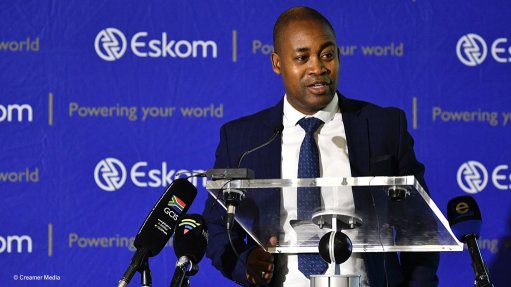Renewables industrialisation plan to be aligned to expected surge in private projects
The newly appointed facilitator of the South African Renewable Energy Masterplan (SAREM) expects a draft document to be completed by mid-2023 and for the final masterplan to be negotiated before year-end.
Gaylor Montmasson-Clair has also indicated that the industrialisation plan will be adjusted to the emerging reality that private rather than public procurement is likely to underpin a significant portion of future demand.
Appointed SAREM facilitator by Mineral Resources and Energy Minister Gwede Mantashe in December, Montmasson-Clair tells Engineering News that significant progress has already been made in researching specific industrialisation opportunities linked to South Africa’s public procurement of renewable energy and storage.
Much of this research and coordination work has hitherto been facilitated by GreenCape, which will continue to provide support to the process.
However, the appointment of Montmasson-Clair, who is the senior economist at Trade & Industrial Policy Strategies, is designed to reignite the process “so as to get SAREM across the line as soon as possible”.
He stresses that he intends to build on the work already done, including the framework provided by the draft masterplan published in March 2022.
That document sets an aspirational target to progressively localise 70% of the components used in solar photovoltaic and wind projects procured under the Renewable Energy Independent Power Producer Procurement Programme (REIPPPP) by 2030, as well as a goal of localising 90% of the balance of plant by that same date.
During the current phase, however, emphasis will also be given to ensuring that the SAREM is aligned to significant changes under way in the South African electricity sector, including the fact that the development of renewable energy in South Africa is unlikely to continue to be dominated by the REIPPPP alone.
When consultations on the SAREM began, it was assumed that most of the solar, wind and storage would be procured through national programmes, such as the REIPPPP.
Subsequent electricity market reforms – including one allowing private distributed generators to build utility-scale projects without a licence and to use the grid to sell to multiple consumers using private power purchase agreements – has significant implications for the masterplan, as well as the policy instruments to be deployed to stimulate industrialisation.
That reform has reportedly already created a 9 000 MW pipeline of private renewables projects and during the sixth bid window of the REIPPPP last year, the 3 200 MW set aside for wind projects could not be allocated, as the grid required for the projects had been reserved by independent power producers operating outside of the REIPPPP.
Although the reform is recent and was initially limited to projects below 100 MW, that cap is in the process of being lifted. In 2022, the National Energy Regulator of South Africa registered 398 such projects, with a combined capacity of 1 659 MW, including 14 above 50 MW.
Montmasson-Clair says this development indicates that, while there will definitely still be an expansion of the South African renewables and storage markets, the SAREM needs to be realigned to the reality that not all of the demand will arise from public procurement processes.
In other words, while local content could be prescribed under programmes such as the REIPPPP, other industrial policy and trade instruments, such as tariffs, will be required to ensure that the private sector projects can also be leveraged in support of both industrialisation and inclusive development, such as transformation and community upliftment.
“Therefore, the delay in finalising SAREM is arguably a good thing, because if the plan had been concluded ahead of these reforms and developments it would not have been fit for purpose,” Montmasson-Clair argues.
He stresses that any plan to industrialise the renewables industry depends on the demand, as well as the consistency of that demand.
“So, the first thing that is needed is to firm this up, as well as to understand what demand will arise from the public sector and what will arise from the private sector.
“It is then possible to determine which instruments are most suited to supporting industrialisation, as well as other goals, such as that of introducing new participants into supply chains,” Montmasson-Clair explains.
An assessment is then required as to which components can be localised competitively for domestic use and potentially for export and which should possibly be supported for strategic reasons.
“The aim is to develop a competitive and inclusive renewable-energy industry and to limit price premiums.
“However, there may be good reasons for offering some trade protection or incentives to ensure that these nascent industries can develop.”
The International Energy Agency (IEA) has warned that there is currently an overconcentration of manufacturing capacity in a handful of countries, notably in China, and that diversification will be required to ensure that supply-chains are not vulnerable to disruption.
However, it also warns that it is not realistic to compete effectively across all parts of the relevant clean-energy technology supply chains and that trade relations will be vital.
The opportunity of this “new industrial age” is significant, however, with a recent IEA analysis estimating that the global market for key mass-manufactured clean-energy technologies will grow by more than three times to $650-billion a year by 2030.
Despite the SAREM being an industrial policy intervention, the Department of Mineral Resources and Energy and the Department of Trade, Industry and Competition (DTIC) are co-leading the project.
As with the other DTIC-led masterplans, however, the SAREM will be the outcome of a negotiation between stakeholders. Besides the two government departments, the SAREM stakeholders include representatives of the renewables industry, including local and international suppliers, as well as labour and civil society representatives.
Montmasson-Clair tells Engineering News that he has been pleasantly surprised by the level of support he has received following his appointment, despite it having been made soon after the disappointment of bid window six, when solar projects with a combined capacity of only 860 MW advanced to preferred-bidder status, despite there having been a 4 200 MW allocation for both wind and solar.
“There appears to be a coalition of the willing to get SAREM over the line,” he asserts.
Montmasson-Clair has already initiated bilateral discussions with various stakeholders and expects to begin convening meetings of reconfigured workstreams soon with the intention of finalising a draft masterplan for negotiation by mid-year.
“If there is consensus on the draft, the SAREM could be finalised soon thereafter, but I am expecting that there could be intense negotiations on the content before commitments are finally made.
“That said, it has to be signed off this year.”
Article Enquiry
Email Article
Save Article
Feedback
To advertise email advertising@creamermedia.co.za or click here
Comments
Announcements
What's On
Subscribe to improve your user experience...
Option 1 (equivalent of R125 a month):
Receive a weekly copy of Creamer Media's Engineering News & Mining Weekly magazine
(print copy for those in South Africa and e-magazine for those outside of South Africa)
Receive daily email newsletters
Access to full search results
Access archive of magazine back copies
Access to Projects in Progress
Access to ONE Research Report of your choice in PDF format
Option 2 (equivalent of R375 a month):
All benefits from Option 1
PLUS
Access to Creamer Media's Research Channel Africa for ALL Research Reports, in PDF format, on various industrial and mining sectors
including Electricity; Water; Energy Transition; Hydrogen; Roads, Rail and Ports; Coal; Gold; Platinum; Battery Metals; etc.
Already a subscriber?
Forgotten your password?
Receive weekly copy of Creamer Media's Engineering News & Mining Weekly magazine (print copy for those in South Africa and e-magazine for those outside of South Africa)
➕
Recieve daily email newsletters
➕
Access to full search results
➕
Access archive of magazine back copies
➕
Access to Projects in Progress
➕
Access to ONE Research Report of your choice in PDF format
RESEARCH CHANNEL AFRICA
R4500 (equivalent of R375 a month)
SUBSCRIBEAll benefits from Option 1
➕
Access to Creamer Media's Research Channel Africa for ALL Research Reports on various industrial and mining sectors, in PDF format, including on:
Electricity
➕
Water
➕
Energy Transition
➕
Hydrogen
➕
Roads, Rail and Ports
➕
Coal
➕
Gold
➕
Platinum
➕
Battery Metals
➕
etc.
Receive all benefits from Option 1 or Option 2 delivered to numerous people at your company
➕
Multiple User names and Passwords for simultaneous log-ins
➕
Intranet integration access to all in your organisation



















